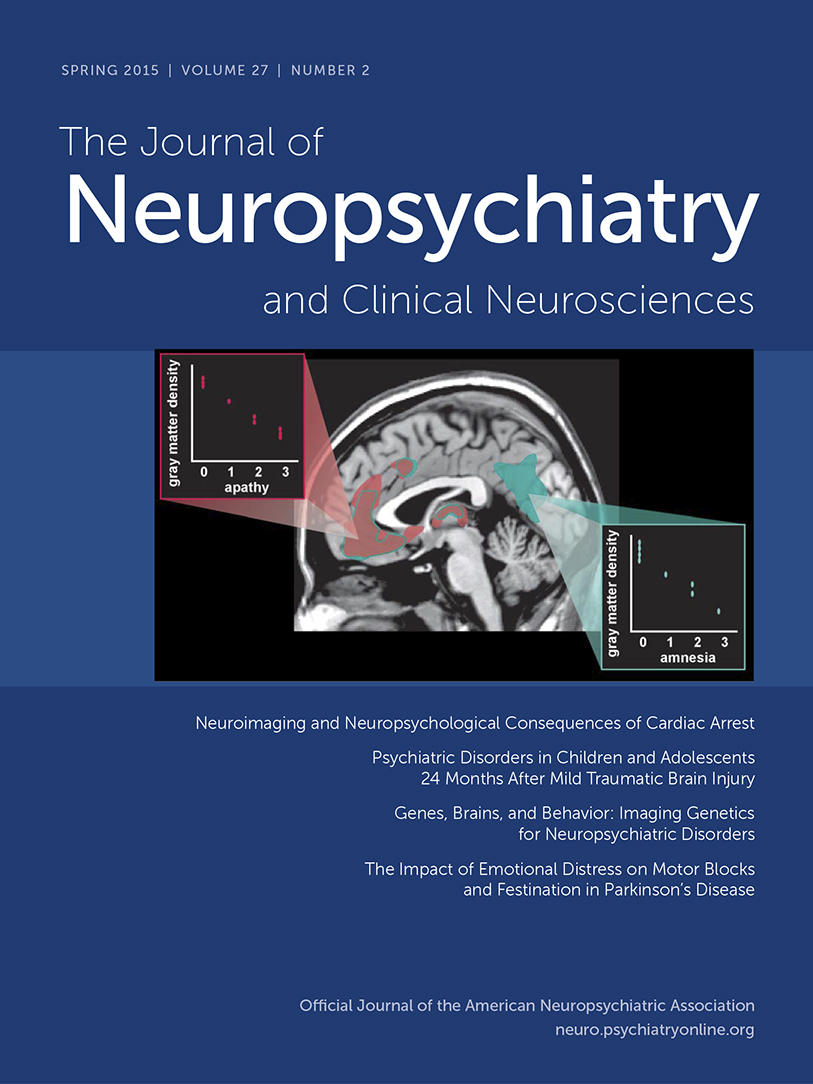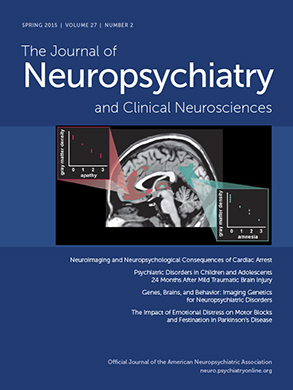To the Editor: Anti–N-methyl-d-aspartate (NMDA) receptor encephalitis is a form of autoimmune encephalitis that was recently identified. It presents with atypical neuropsychiatric manifestations. Patients with anti–NMDA receptor encephalitis develop a progressive illness from psychosis into a state of unresponsiveness with catatonic features, often associated with abnormal movements and autonomic instability. Here, the authors describe the case of a 35-year-old woman with anti–NMDA receptor encephalitis, who presented with psychiatric manifestations.
Anti–NMDA receptor encephalitis belongs to the autoimmune and paraneoplastic encephalitides.
1 Once conceptualized as a condition primarily affecting adult women and frequently associated with tumors, anti–NMDA receptor encephalitis is increasingly recognized in men and children as well as in the absence of tumors. Most patients exhibit psychosis, memory loss, seizures, and language disintegration and may develop unresponsiveness with catatonic features or periods characterized by abnormal movements, including autonomic and breathing instability.
2 The presence of a tumor (usually an ovarian teratoma) is dependent on age, sex, and ethnicity and is associated with a better prognosis after tumor resection and immunotherapy (corticosteroids, intravenous immunoglobulin, plasma exchange) than in patients who do not have tumors. More than 75% of all patients recover in association with declining antibody titers, but relapses are frequent, and close follow-up is necessary for at least 2 years after the initial diagnosis.
2This case report describes a 35-year-old woman who presented to us with psychiatric manifestations due to anti–NMDA receptor encephalitis.
Case Report
A 35-year-old married woman, from an urban background and middle socioeconomic status, employed by a multinational company, presented to us with acute onset abnormal behavior for 4 days. She complained of restlessness and difficulty in initiation of sleep. She was dull and showed reduced interest in interacting with family and expressed feelings of loneliness and depressed mood occasionally. When family members tried to talk to her, she would laugh without any reason. She reported hearing sounds of drums when none existed and would ask family members if they could hear these sounds. There was no history of suspecting people to be against her, hearing of voices discussing about her, her thoughts being known by others, expressing pervasive sadness, worries of future, or suicidal ideations. There was no history of fever, headache, vomiting, substance abuse, seizures, head injury, or loss of consciousness. Finally, there was no history or family history of any psychiatric illnesses and the patient was premorbidly well adjusted.
A general physical examination revealed blood pressure of 130/84 mmHg and a pulse rate of 84 bpm, and the patient was afebrile. A detailed neurological examination revealed normal power and tone of muscles as well as normal Babinski reflex and no signs of meningeal irritation.
A provisional diagnosis of “acute polymorphic psychosis without symptoms of schizophrenia” was made per ICD-10 criteria, and the patient was started on oral aripiprazole 10 mg/day and oral lorazepam 2 mg/day. Over the next 3–4 days, the patient developed progressive psychomotor retardation and stopped answering questions or following the commands and exhibited negativism, mutism, and episodes of staring for 15–20 minutes. On repeated instruction, she would open her mouth, exhibited ambivalence to protrude her tongue, and responded to painful stimulus suggesting stupor. Occasionally, she exhibited echolalia, mimicked the sentences of the people who tried to talk with her, and developed urinary incontinence. Lorazepam was increased to 12 mg/day and aripiprazole was discontinued. Supportive care in the form of intravenous fluids and feeding through a nasogastric tube was provided. An exhaustive biological checkup was conducted to rule out possible organic causes. Her complete serum electrolytes, hemogram, and liver, renal, and thyroid function tests as well as an MRI scan of the brain were within normal limits. The patient did not show signs of improvement even after 72 hours and continued to be in a state of stupor. An EEG showed diffuse slowing of waves; a CSF study showed increased polymorphic pleocytosis and increased proteins. Empirically, she was treated with prednisolone 1 g/day i.v. for 10 days. There was no improvement, and the patient developed orolingual and limb dyskinesias. Considering the possibility of limbic encephalopathy, the patient was evaluated for NMDA receptor antibodies in her serum, which were found to be strongly positive. A further gynecological evaluation and CT chest and abdomen scan were performed, which revealed a right-sided ovarian mass (dermoid) measuring 8.3×5.3×6.9 cm. The patient was referred to a surgical oncologist for excision of the tumor. After the surgical excision of the tumor (benign teratoma), the patient gradually improved over the next 2 months. The NMDA receptor antibody titer was reassessed 3 months after surgery and was negative. After 6 months of follow-up, the patient is able to walk unaided, perform her household chores, and is functionally back to her premorbid state (
Table 1).
Discussion
When faced with a patient like the one presented here, there are data to guide the clinical decision-making process. The targeted management of psychiatric symptoms remains unclear. Psychiatric treatments described in the literature on autoimmune encephalitis focus primarily on the management of catatonia with ECT.
3 Therapeutic approaches to catatonia are mainly symptomatic. It is recommended to use high doses of benzodiazepines and to perform ECT in case of resistance or a life-threatening condition.
3 Treatment of the causal organic condition is warranted. In our case, anti–NMDA receptor encephalitis presented with features of acute psychosis, deteriorating to catatonic stupor. The patient did not respond to high doses of lorazepam. ECT was discussed but not considered due to the presence of a CSF abnormality.
Management of anti–NMDA receptor encephalitis is focused on immunotherapy and the detection and removal of the teratoma.
2 Based on an extensive review by Dalmau et al.,
2 the first line of immunotherapy consists of corticosteroids, intravenous immunoglobulins, and plasma exchange (alone or in combination). The second line of immunotherapy (rituximab, cyclophosphamide, or both) is usually needed in the case of a delayed diagnosis or in the absence of a tumor.
2 The outcome improves after removal of the teratoma, if present, in combination with immunotherapy.
4,5 Relapses have been noted in approximately 25% of young patients and seem to occur while tapering immunotherapy, as well as in cases without teratoma in those with high titers of anti–NMDA receptor antibodies in the CSF. Follow-up evaluation should include neurologic and psychiatric examinations, ultrasounds, MRI scans of the pelvis and abdomen, and measurements of the levels of anti–NMDA receptor antibody titers in the serum and CSF.
6Conclusions
Recognition of encephalitis by psychiatrists is important because patients may initially present with psychiatric manifestations and catatonic features. Psychiatrists may encounter patients with autoimmune encephalitis in emergency departments, inpatient units, consultation liaison services, and outpatient settings, and thus should have a basic understanding of the clinical characteristics, differential diagnosis, and currently available treatment interventions. Once specific anti–NMDA receptor antibodies are detected, it is crucial to start specific treatment, including tumor removal and intense immunotherapy, immediately. This disease has a good prognosis in the majority of cases if diagnosed and treated early.
Acknowledgments
The authors thank the subject and her relatives for giving consent to publish the data for academic purposes, without which the study would not have been possible.

